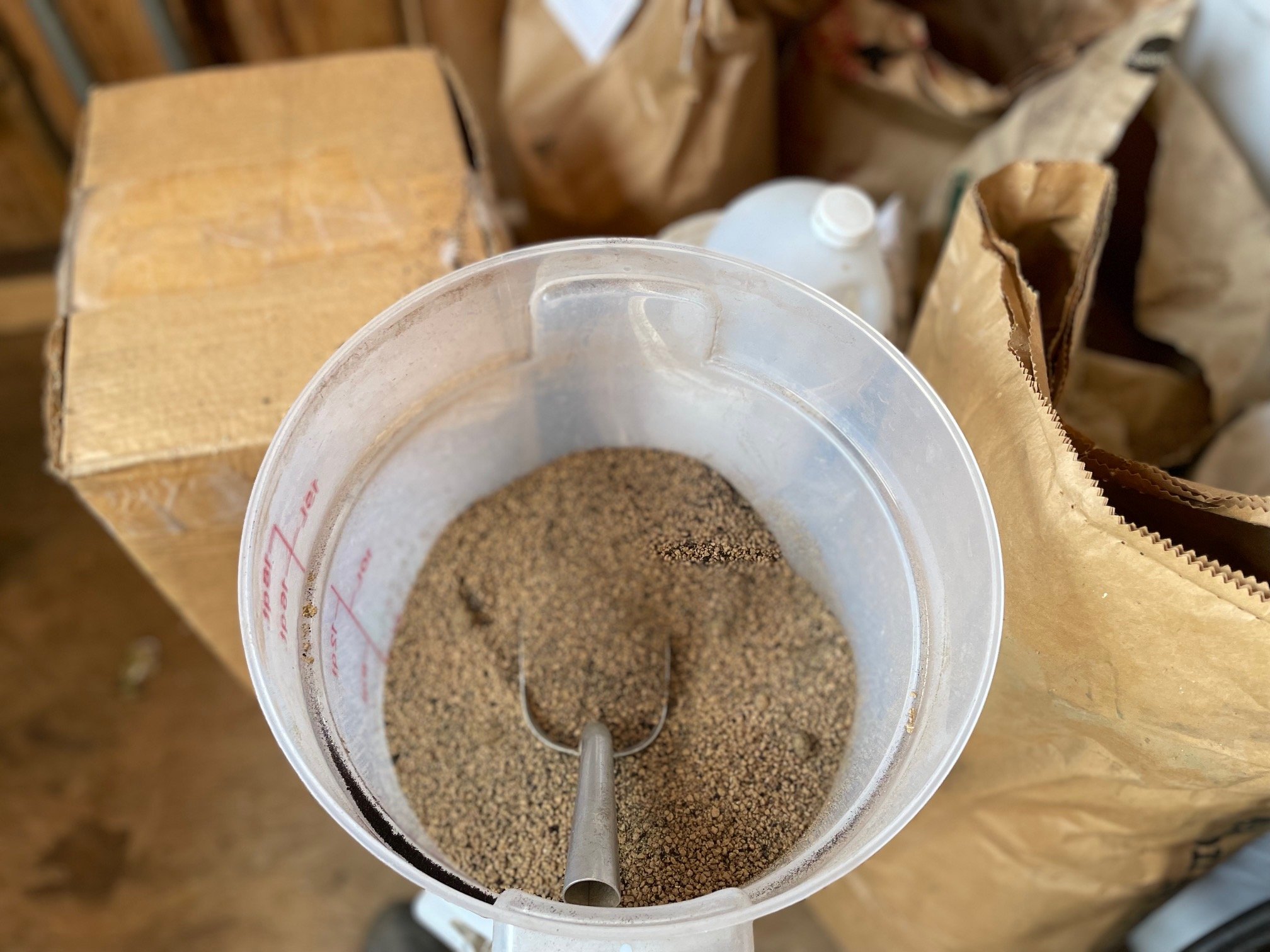Calculating Fertilizer Blends
If you are a farmer or gardener then you probably use some kind of fertilizer. From here on my soapbox, I hope its an organic one, but even so calculating fertilizer application rates and combining them to form a blend without overloading your soil with excess nutrients is a mathematical problem that all types of farmers face.
In this blog post I will share with you
some of the basic info you’ll need to gather first, then talk through
some of your considerations when deciding on fertilizers, then
share a spreadsheet based calculator I built to help figure out fertilizer blend application rates.
Soil Testing
Your first step to deciding the fertilizer needs of your soil is getting a soil test performed by your extension agent or a private lab. If you plan to apply compost, you may also want to test your compost batch. Most labs will then inform you how much you need to "add” based on your results, your intended crop, and previous crop. Its worth noting that incorporating a cover crop will provide some of the nutrient needs of the following crop (more on that HERE).
If you are trying to understand a soil test you can find some regional guides like THIS ONE that walk you through your test report, and what the optimum levels are.
For me, a farmer without academic training, soil tests, and amendments are always something that I try to have a consultant double check me on. I love working with Mark Schonbeck who has a long history of organic consulting and translates the chemistry language into a narrative report that provides me with instructions on what to buy, apply, and observe next.
Amendment shopping
Now that you know what elements are lacking in your soil, you can hit the marketplace and see what kinds of products are on the market. Being in Floyd County, I always work with Seven Springs Farm, but so do many other organic growers because they ship all over the country and provide great advice if you need it.
When you are buying a bagged commercial type fertilizer, they are marked with a “guaranteed analysis”. This is a breakdown of nutrients by weight, explained as a percentage. The shorthand version of a guaranteed analysis is a three number sequence printed on the bag. (example: 12-0-0 OR 5-4-3 OR 9-0-9). If all you see are those numbers, then you know the N-P-K amounts in that product. Whats N-P-K? Nitrogen, Phosphorus, Potassium (in that order).
So a bag labelled 5-4-3 would be… 5% Nitrogen(N)- 4% Phosphorus(P2O5)- 3% Potassium (K) by weight.
Plant Requirements
If your soil testing lab or consultant didn’t already tell you how much of each nutrient to apply, you’ll want to consult a reference chart. I like to use the Knotts Handbook, or this Cornell Reference Chart but extension can always connect you with most recent recommendations coming from your ag universities, depending on your crop.
Lets say…If you are low in Nitrogen, but already high in Phosphorus, then as you look at your options for fertilizers, you’ll want to find something that has mostly Nitrogen (first number) and no Phosphorus (a zero or very little in second number). However, many fertilizers have some of each, which makes it hard to figure out the best way to blend them. You could accidentally apply too much of one nutrient, by trying to satisfy the needs of another by using a fertilizer that is 10-10-10.
Another consideration on your fertilizer selection is whether it is fast acting, or slow release. For my sandy soils, they tend to lose nitrogen quickly, so I don’t want to apply all fast acting fertilizers, but rather choose slow release, and side dress or foliar feed later if needed.
Using a Calculator
Let’s say you want to grow endive, and your consultant recommends 100lbs of N per Acre based on your soil test.
You find a product called “KATZZ” online that is 10-0-0
You have one Acre
How many lbs of KATZZ do you apply? 1000 lbs!
Recommended Rate (in lbs/Acre) ✖️ 100 ➗ Number in Garaunteed Analysis= RESULT How Much to Apply Per Acre
Then, if you have more (or less) than one perfect acre, multiply your RESULT ✖️ # of Acres= how much KATZZ to spread.
Its Complicated! Thats why I created a spreadsheet calculator for myself to use.
How to Use the Spreadsheet
Lets dive in.
First Make a copy of the spreadsheet and save the copy in your own google drive (this gives you full access to editing, but beware! don’t edit cells that contain formulas or the spreadsheet will fail to function properly)
Define your area by entering in length and width of the bed or garden you want to fertilize, or enter in larger fields. The spreadsheet will figure out for you how many Acres (in decimals) that is.
Enter your goals which are the nutrients you need to add to your soil this season. There is a spot to factor in your compost and standing cover crop if you wish. These both supply some of your nutrient needs.
Pick your priority You’ll need to choose N, P, or K as your priority for your fertilizer. Since the spreadsheet is dong complex math, this selection helps narrow its focus. Your priority is likely going to be Nitrogen, but perhaps you are extremely deficient in Potassium, so you may select K for that reason.
Enter Your Fertilizer Info by typing the name(s) in column C,
Enter More Fertilizer Info by entering the garaunteed analysis(es) in columns R through AC.
Adjust the Blend if you want to blend multiple fertilizers to meet your goals, you can enter percentages from 0-100 in column B. Making sure the total adds up to 100. If you want, you can enter all your fertilizers in here, but simply change them to 0 when you are not using them for the blend you are currently calculating.
See how much to apply once everything in steps 1-6 have been filled in you can take a look at columns D, E, and F. Which one is highlighted? That is the column containing the amount of lbs of each product you will apply to your defined area!
Before applying it you’ll want to double check line 41 and 42.
Line 41 tells you your total application amount for each nutrient in Pounds per Acre
Line 42 tells you if you are deficient, sufficient, or excessive in your application amounts. If you see red that indicates your blend being excessive or deficient in that nutrient so you may need to adjust the percentages or select a different fertilizer with a better fitting analysis.
Applying Fertilizer
Okay, so you are probably ready to go apply your fertilizer and want to know HOW? if you are on a larger scale you may be applying your fertilizer with a spinner spreader or drill, on a medium scale you may be flinging it with a manual spreader or applying it to your compost and then spreading that. On my tiny 1/4 acre scale I figure out how much of each fertilizer I need on a PER BED basis, then I make custom sized scoops that correspond with that weight. Each time I need to fertilize a bed, I then know it will take just one scoop of this, one scoop of that and my blend gets mixed up in a 5 gallon bucket. I take it out and fling it onto the bed by hand (sort of like I am appling powdered sugar to a yummy brownie), starting out light and making sure I coat the bed surface evenly. I often put down compost at the same time (another one of my fertilizers). then I can seed and plant into that bed and feel confident things will grow healthy! I try to do all my raking and forking before the fertilizer goes down, because raking the bed after fertilizing tends to make the amendments unevenly distributed and I get weird crop growth, so instead I wait, and let the seeder, and my cultivating passes, and irrigation work the fertilizer down into the root zone as the plants grow.
More Resources for You
https://www.7springsfarm.com/pages/resources
http://nmsp.cals.cornell.edu/publications/files/VegetableGuidelines2019.pdf
https://projects.sare.org/wp-content/uploads/Northeast-Organic-Grower-Crop-Manual-2022.pdf
https://precisionag.sites.clemson.edu/Calculators/Fertility/fertBlend/
https://www.clemson.edu/extension/precision-agriculture/calculators/index.html



